
African military systems after 1800
Encyclopedia
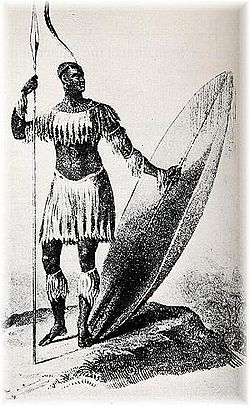
African military systems to 1800
African military systems to 1800 refers to the evolution of military systems on the African continent prior to 1800, with emphasis on the role of indigenous states and peoples. Development of the military art generally moved from the simple to the more sophisticated as economies and cultures became...
. Coverage of the 20th century and beyond is illustrated in African military systems after 1900
African military systems after 1900
As the 20th century started, most of Africa, with the exception of Ethiopia and Liberia was under colonial rule. By the 1980s, most nations were independent...
. For an overall view of the military history of Africa by region, see Military History of Africa
Military history of Africa
The military history of Africa is one of the oldest and most eclectic military histories. Africa is a continent of many regions with diverse populations speaking hundreds of different languages and practicing an array of cultures and religions...
. See individual battles, empires and leaders for details on activities after 1800.
African military systems and the 19th century
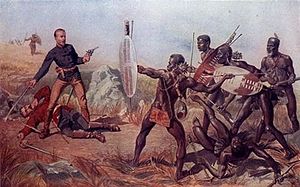
- The rise of the Zulu kingdom under Shaka, which created significant change - from the southern part of the continent, up into East and Central Africa
- The Islamic-inspired military jihads of West Africa, causing substantial transformation in that region on into the belt of Sudanic states
- The increasing volume of guns delivered to the continent
- The growth of trade between Africa and other parts of the world, including the suppression and replacement of the slave trade with other commerce
- The explosion of European interest in Africa, culminating in invasions, settlement and acquisition of colonial empires in different parts of the continent
All these factors in part continued earlier trends but the 19th century was to see an acceleration in the pace of military evolution on the continent. The environmental variables of past centuries also continued in many areas. Some of these include:
- Relatively low population densities that reduced forces for combat
- Poor soils (particularly in tropical forest areas) and low crop productivity
- Disease-carrying vectors that hindered deployment of weapons systems like cavalry and weakened infantry forces in many regions
- Lack of good coastal harbors and navigable rivers - hindering large scale logistics
These variables impacted the development of military systems. Low population densities for example meant that large forces could not be raised and maintained in being for a long time. The Zulu as one instance, could field an estimated 50,000 warriors, impressive by regional standards. But this was the nation's entire armed strength, whereas more populous European nations during the Napoleonic Wars of the 19th century could routinely put this amount of men into a single battle. Political fragmentation also hindered the growth of large armies, and African tribes could be divided and defeated separately by foreign invaders, just as Rome did with numerous tribal opponents in antiquity. Nevertheless, despite such limits, the internal consolidation and growth of African states played an important part in military transformation. The Zulu system for example did not rely on foreign horses, guns or ships. The evolution of African military systems is thus not a simple tale of outside influences but a complex web of indigenous development that adapted, shaped and sometimes rejected outside technology.
The influence of the gun and other technology. The introduction of firearms was important, but guns on African battlefields were often of indifferent quality, and traditional weapons and tactics sometimes compared favorably with them. Indeed Africans were well aware of the deficiencies of trade muskets and often demanded better quality than that offered. Most guns imported from Europe had not been test fired by the manufacturer to check for imperfections in bore and breach, although this was essential in the era of hand-forged barrels. Proven guns had proof-marks, and counterfeits flourished in the Africa trade. Firearms were thus a mixed bag on the ground, and the success of consolidating native powers like the Merina in Madagascar or the Zulu were due more to changes in indigenous organization, leadership and tactics, than to firearms. As the decades rolled on however, improvements to firearms, and other technology such as disease control (the cinchona bark to suppress malaria for example), and steamships were to give Europeans a decisive military edge on the continent.
Naval developments

Generally cannons were placed in the bow or stern, with the boat absorbing the guns' recoil. The whole vessel had to be turned to deliver salvoes. Compared to European use of naval cannon, such artillery saw limited use in ship to ship engagements, or shore bombardments. As stand-off weapons covering troop landings or raiding missions however, they had serviceable anti-personnel value, particularly when combined with muskets. In Nigeria, large war canoes are reported, some mounting up to twenty pairs of swivel-guns on cross-beams at intervals of five or six feet. In 1841, the ruler of Abo was reported to muster some 300 canoes, many armed with muskets and bow/stern cannons. Some canoe fleets however relied on traditional weapons. On Lake Chad in the early 19th century the piratical Buduna fielded a fleet of some 1,000 reed canoes, using spears and shields for armament, and in East Africa, native kingdoms sometimes vied for supremacy with large numbers of canoes on the region's great lakes.
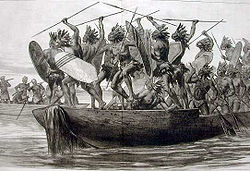
Naval developments mirror those on land. New technology like firearms was adapted and shaped to existing indigenous politics, technology and forms of organization. The landscape also played its part- limiting major, long-term water movement by rivers that were unnavigable for long stretches, contrary currents, and lack of good coastal harbors. Few native powers attempted any significant upgrades involving intensive sailing technology, or took to the oceans with long-distance ships in the European, Polynesian or Chinese manner. No African equivalent of the famous, ocean-spanning Chinese fleet admiral Cheng Ho was to emerge, although a number of inland captains rose to prominence. The days of Carthage long gone, African naval power remained primarily a localized phenomenon.
Land warfare in the 19th century
The post 1800 period saw a quickening of European expansion and conquest in Africa. This expansion did not go unopposed, nor was such activity the only significant military development on the continent. Indigenous states in all regions were developing new forms of political organization and military structure independently of, and before the major European interlude.Cavalry and infantry in West Africa
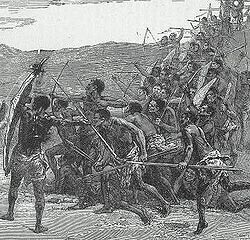
Battle of Tsuntua
The Battle of Tsuntua, fought in December 1804, was one of the largest battles of the Fulani War.In 1804, Yunfa of Gobir realized the growing threat that his former teacher, Fulani Islamic refomer Usman dan Fodio, posed to the Hausa city-states. Appealing to the other Hausa rulers for help, Yunfa...
where some 2,000 men were lost.
Fulani innovations in infantry tactics. The cavalrymen of Gobir, under their leader Yunfa, initially mocked the inability of the Fulani to use horses effectively, but the Fulani replied with their own trump card, massed arrow fire, at the Battle of Tabkin Kwotto. Ordinarily, such fire would have been delivered by scattered bowmen in loose formation, vulnerable to quick charges by the Gobir chevaliers. In this particular battle however, the Fulani anchored their formation in a fairly wooded area, with one flank of their army resting on a lake. Although the cavalry of Gobir outflanked their opponents, the center of the Fulani formation held this strong position. Rather than deploy in the usual open skirmishing order, the Fulani bowmen adopted a square, grouping their archers in a compact block, and concentrating the firepower of their poisoned arrows. This broke the back of the Gobir formations, despite their armor.
The tactics of the Fulani were continually refined over time, as they gained more victories and themselves began to acquire numbers of horses for their own cavalry arn. Dan Fodio wrote on tactics employed by his forces as the jihad campaign unfolded: The infantry armed themselves with large shields (diraq) and carried long lances and javelin. Grouped into ranks, a spearman knelt on the left knee, holding his round shield before him. Behind the ranks of spearmen the archers stood ready. They were ordered to shoot at the enemy horse and men in chain mail (duru). As the enemy cavalry approached the infantry would launch its javelins and the archers would keep shooting. If the enemy wavered, the infantry formation formation would then part left and right, so that their own cavalry was unleashed in pursuit. The writings of Dan Fodio on tactics echo a sentiment that would be approved by many a military commander: "Concentration is the first thing in victory: the beginning of defeat is dispersion."
Continued relevance of the cavalry-infantry combination. Cavalry still continued to be relevant in the 19th century. The Caliphate of Sokoto, was West Africa's largest single state during this period, and had its genesis in the many Muslim jihads across the region. Sokoto's core strike force was cavalry, although the bulk of its armies consisted of archers and spearmen. On the flat terrain of the savannahs, this combination did relatively well against indigenous opponents, although deployment in forested regions, and operations against fortifications suffered from the problems of earlier eras. Infantry, and their muskets, became increasing more important and dominant in some savannah areas as the decades progressed. Sokoto and several other cavalry-elite empires like Gobir however, continued to place their trust in the traditional weapons and fighting styles. This "old ways" approach of Sokoto can be seen in such battles as the 1826 clash with the state of Gobir, where some elite units of armored Sokoto cavalry had to be lifted on to their horses, like the medieval knights of Europe. It should be noted however that the cavalry-elites depended heavily for their successes on cooperation with lesser esteemed infantry, who were critical in opening opportunities for attack, fixing an enemy into an unfavorable position, or in suppressing deadly counterfire by poisoned arrows. This conservatism in methods was to continue on into the 20th century, when the Sokoto hosts clashed with the modern weaponry of the British Empire.
Organization, equipment and tactics
Mobilization, recruitment and logistics. From about 1700 to 1820, no nation on the Gold Coast of West Africa (region of modern-day Ghana) excelled the Ashanti in the scale of their military organization and activity. Wars of conquest made them the major power in the area, and they fought and won several major clashes against the British, before going down to defeat in the latter part of the 19th century. A small core of professional warriors was supplemented by peasant levies, volunteers and contingents from allied or tributary tribes. Grouped together under competent commanders such as Osei Tutu and Opoku Ware, such hosts began to expand the Ashanti empire in the 18th century on into the 19th, moving from deep inland to the edges of the Atlantic. One British source in 1820 estimated that the Ashanti could field a potential 80,000 troops, and of these, 40,000 could in theory, be outfitted with muskets or blunder-busses.Arms and equipment. The Ashanti became familiar with firearms in the 18th century, and by the 19th century, the bulk of their best troops were armed with a variety of guns, such as the standard European trade muskets, 6 feet in length, so-called "Long Dane". The Long Dane, and other improved Africa-trade models that came into service over the years, were serviceable weapons in local context, but obsolete compared to first-rank European firearms. This was to cause problems against strong British forces in later wars. General Nkwanta, head of the Ashanti army's general council is reported to have done a detailed assessment of new breech-loading European firearms in 1872–73 and was troubled by the obsolescence of Ashanti muskets in comparison. Some of the muskets burst after a few firings, and good quality powder and shot were in short supply. Most of the tribal gunmen in addition, did not use wadding to compact the powder down into the barrels but simply dumped in it, then added a variety of lead slugs, nails, bits of metal or even stones. This made an impressive pyrotechnic display, but unless opponents were at very close range, the muskets were ineffective. The huge explosion and kick of the muskets also meant that men preferred to fire from the hip, causing them to aim high, with inaccurate results.
Available guns were valued however, and carefully protected with leather or leopard skin covers, as were the pouches of ammunition each fighter carried. Soldiers carried thirty to forty gunpowder charges within reach, individually packed in small wooden boxes for quick reloading. Good bullets were scarce, and gunners were forced to use such substitutes as stones, metal pieces, and bits of lead. Compared to the European enemies they were to face in their later history, the weapons of the Ashanti were poor. The Ashanti fighting man also wore a buckskin belt, carrying several knives of various lengths. The belt also held a machete for cutting through bush, or hand to hand combat.
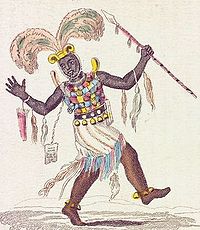
- Scouts (akwansrafo),
- Advance guard (twafo)
- Main body (adonten),
- Personal bodyguard (gyase)
- Rear- guard (kyidom)
- Two wings-left (benkum) and right (nifa). Each wing having two formations: right and right-half (nifa nnaase), left and left-half (benkum nnaase)
On the move the army used this general breakdown- advance guard, main body, rearguard, and right and left wings. This detailed organization had several advantages, enabling the Ashanti generals to maneuver their forces with flexibility. The scouts performed recon and carried out pursuit operations. The advance guard could serve as initial storm troops or bait troops- getting an enemy to reveal his position and strength. The main body applied the bulk of the army's striking power. The personal bodyguard protected the king or high ranking nobles or generals in the field. The rear guard might function for pursuit, or as a reserve echelon. The two wings might attempt to carry out encirclement of the opposing force, or even strike at the rear.
Individualized acts of daring were encouraged, such as rushing out into the open to chop off the heads of wounded or dead enemies. A tally of these trophies was presented to the commanding general after the end of the engagement. Severe discipline prevailed in the Ashanti armies. Soldiers who faltered were whipped or slaswed with heavy swords carried by special contingents of "enforcer" troops - the "sword-bearers." . Ashanti soldiers had to memorize the following saying: "If I go forward, I die; if I flee, I die. Better to go forward and die in the mouth of battle." Generally the "enforcers" were deployed forward, between the scouts and the main force. They eased back as the battle started to better observe and intimidate the weary and faltering. In a feature seldom seen among African armies, the Ashanti also deployed units of medical personnel behind the main forces, who were tasked with caring for the wounded and removing the dead.
Ashanti tactics. The flexibility of the Ashanti tactical system called for a large measure of decentralization, important in the thick forest terrain of Western Africa. This heavy jungle growth often hindered large scale clashes in the open involving thousands of men, as was seen among peoples like the Zulu or the Ndebele. Ashanti methods thus involved smaller tactical sub-units, ambushes, constant movement, and more dispersed strikes and counter-strikes. In one unusual incident in 1741 however, the armies of Asante and Akkem agreed to "schedule" a battle, and jointly assigned some 10,000 men to cut down trees to make space for a full scale clash. The Asante won this encounter.
One 1844 British commentary on Ashanti tactics claims that they commenced operations by cutting a number of footpaths in the brush to approach and encircle the enemy force. Once reaching the initial jump-off point, Ashanti troops formed in line and attacked. Other accounts compared the Ashanti marching order to that of ants, with the use of several parallel columns that joined into one general striking force maneuvering before combat. Such a "converging columns" approach was ironically used by the British themselves in fighting the Ashanti, and is a tactic that appeared on the battlefields of Europe under Napoleon, as 'march divided, fight together' was the original raison d'etre of the division
Division (military)
A division is a large military unit or formation usually consisting of between 10,000 and 20,000 soldiers. In most armies, a division is composed of several regiments or brigades, and in turn several divisions typically make up a corps...
. These standardized tactics had often yielded the Ashanti victory. Scouts screened the army as it marched in its columns, then withdrew as the enemy became close. Upon the beginning of combat, the advance guard moved up in 2 or 3 lines, discharged its muskets and paused to reload. The second line would then advance to fire and reload, A third rear line would then repeat the advance - fire-reload cycle. This "rolling fire" tactic was repeated until the advance halted. Flanking units would be dispatched as part of the fire and maneuver model.
The Ashanti versus the British
In facing the British, the Ashanti did not change their traditional tactics appreciably. They had initially advanced across the Prah River in a regional campaign before being confronted by an English invasion force. Beset by severe logistics problems, smallpox and dysentery they had pulled back across the river. Nevertheless their battle plan was one that had worked earlier. The Ashanti sought to draw the British deep into their territory, against a strong defensive anvil centered at the town of Amoaful. Here the British would be tied down, while maneuvering wing elements circled to the rear, trapping and cutting them off. Some historians (Farwell 2001) note that this was "hammer and anvil" approach was a traditional Ashanti battle strategy, and was common in other African armies as well. It had served the Ashanti well against other African forces, and had beaten the British under Governor Charles McCarthy of Sierra Leone once before. In 1824 M'Carthy had advanced with a small force of African and colonial militia, and encountered 10,000 Ashanti at the village of Essamako. Perhaps hoping to sustain internal morale and/or overawe the opposing natives, McCarthy ordered the band of the Royal African Corps to play "God Save The King". The Ashanti moved up drums and horns and in turn struck up their own music, before launching an encurcling attack. The British were quickly routed and M'Carthy was captured and beheaded, with his skull later serving as a drinking cup.At the village of Amoaful, the Ashantis succeeded in luring their opponents forward according to plan, and threatened them several times by flanking movements. Ashanti weaponry however, was poor compared to the modern weapons deployed by the redcoats, a point noted in the British accounts, and such superior arms served the British well in repulsing the Ashanti encirclements: "The Ashantees stood admirably, and kept up one of the heaviest fires I ever was under. While opposing our attack with immediately superior numbers, they kept enveloping our left with a constant series of well-directed flank attacks." Enemy commander General Garnet Wolesey had anticipated Ashanti tactics and had strengthened the British flanks with the best units and stronger firepower. The earlier successes of the African kingdom were thus not repeated.
Another tactic of the Ashanti during later wars against the British was to create powerful log stockades at key points to block British advances. Some of these fortifications were over a hundred yard long, with heavy parallel tree trunks sometimes impervious to destruction by artillery fire. Behind these stockades numerous warriors were mobilized to check enemy movement. While forminable in construction, many of these strongppoints failed because Ashanti guns, gunposderr and bullets were poor, and provided little sustained killing power in defense. Time and time again British troops overcame or bypassed the stockades by mounting old-fashioned bayonet charges, after laying down some covering fire. The Ashanti had given up effective use of traditional weapons like spears, and had little effective reply to the cold steel of an infantry charge except the weak volleys of their obsolete or malfunctioning
Firearm malfunction
A firearm malfunction is the partial or complete failure of a firearm to operate as intended. Malfunctions range from temporary and relatively safe situations, such as a casing that didn't eject, to potentially dangerous occurrences that may permanently damage the gun and cause injury or death...
muskets. Supplementary weapons like bush knives made an indifferent showing in these tactical situations against the European soldiers. The presence of African enemies also fighting alongside the British with their customary tribal arms also added to Ashanti woes. Supposed advanced technology in this case, the gun, became ironically, a handicap for the indigenous forces. By contrast, the Zulu retained the effective use of their traditional spears, generally forcing the British to remain in packed defensive formations or entrenched strongpoints, protected by guns and artillery.
Effectiveness of the Ashanti
Some British commentary draws a sharp contrast between Ashanti fighting qualities and the shakiness and unreliability of the coastal tribes, ostensible allies of the invaders. At Amoaful, one combat post-mortem pays tribute to the Ashanti commander: "The great Chief Amanquatia was among the killed. Admirable skill was shown in the position selected by Amanquatia, and the determination and generalship he displayed in the defence fully bore out his great reputation as an able tactician and gallant soldier."While the numbers fielded and weaponry compared unfavorably to the mass armies and industrial output of contemporary Europe, the Ashanti were a strong regional power, that did relatively well until confronted by the most advanced technology of a major world power in the latter half of the 19th century. As one Western historian observes:
- "From 1807 to 1900, Asante armies fought numerous small and large battles against the British. In several of these they were the clear victors, the only West African army to defeat a European army in more than one engagement."
Resistance to colonial expansion: Samori and Abd el-Kader
The policies of Samori Ture of Mali and Guinea and Abd el-Kader of Algeria illustrate how African states were expanding internally, while fighting foreign invasions. Both adapted to modern arms in performing these tasks.Abd-el Kader in Algeria
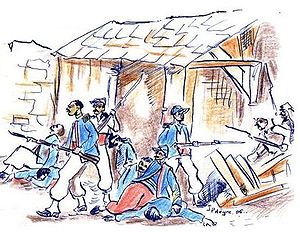
French investments to crush the resistance were massive. By 1839 they had concentrated some 70,000 men in Algeria. By 1844, a third of the French Army was fighting in Algeria - some 108,000 troops - a stark and extraordinary contrast to the typically small European or European-led forces that conquered most of Africa. French tactics changed to counter the swift guerrilla attacks of the native resistance. Heavy formations were broken down into mobile columns, and a ruthless "scorched earth" policy of devastation, plunder and destruction was enacted- seeking to break the native resistance by destruction of its resource base. Wells were poisoned, livestock shot, fields, houses and villages burned, and inhabitants driven into the countryside or exterminated. The ruinous devastation of the countryside severely hurt the Emir's war-making efforts, as did the seizure of his strongholds by the mobile columns. By 1844, El-Kader was forced to withdraw from Algeria to Morocco. Subsequent developments saw his capture and imprisonment by the French, who confiscated massive quantities of native land for settlement of French colons or settlers. This set the stage for an equally bloody resistance war, a century later.

Samori in Guinea and Ivory Coast
Internal conquests of Samori. The armies and operations of African leader Samori Ture offer another illustration of the diversity, strengths and weaknesses of indigenous African military systems, both prior to and after clashes with expanding European colonial powers. Samori's resistance campaign is similar to that of the tribes of Algeria, both in the enemy he fought, and chronic shortages of modern weapons. There is however contrast with Abd el-Kader. Samori's main forces were infantry as compared to horsemen, and he pursued a "scorched earth" approach before the French to deny them resources, the reverse of the pattern under El-Kader. Samori was also a conqueror in his own right even before the coming of the French.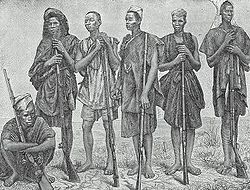
The aggressive expansion of the French brought them into conflict with Samori's empire. The Samorian army was also constantly on the move, fighting on multiple fronts. Faced with French pressure in the west, Samori moved east, conquering areas in the Ivory Coast and Liberia as he maneuvered for combat and logistics space. A large number of civilians moved with the army. The discussion below is drawn from studies such as ‘’(Martin Legassick, Firearms, Horses and Samorian Army Organization 1870-1898, The Journal of African History, Vol. 7, No. 1, (1966), pp. 95-115’’)
Structure of the Samorian army. Primarily infantry with cavalry as a smaller arm, the army structure consisted of 4 parts: the regulars (primarily slaves and captives), a mixed, less standardized conscripted reserve, detachments sent by allied or tributary chiefs, and a cavalry force. The basic rank of a regular infantryman was the sofa. The basic unit was a squad of ten, progressing to a company sized unit of 200-300 men, and thence to larger groupings, typically of approximately 1,000 men. Squad and company leaders were generally mounted. Estimated numbers of fighting men are a source of debate, but the highest places an operational army at around 20,000 men. Of these about 5,000 were "regular" forces. This small permanent army of sofa-kun, directed and stiffened a larger mass of reservists.
Weapons and logistics. The Samorian army did manage to acquire a large number of repeating rifles. Replacement and resupply however including ammunition, was a continuing problem. Freetown, under British rule in Sierra Leone, was an important source of supply. The French tried incessantly to cut this pipeline, and finally did in collaboration with the British. An attempt was made to manufacture guns indigenously, but quality was poor, although the African gunsmiths did succeed in rendering a workable breech mechanism, and in various repairs. Ammunition was also manufactured, and was so precious that after each battle, empty cartridge cases and even bullets were collected.
Tactics of the Samorian army. Lacking good firearms and ammunition, major battles were fought by means of carefully arranged fixed lines, to maximize available firepower. Once these were disrupted however, they were difficult to reconstitute. The main forces however turned in excellent performances based on the accounts of French opponents, who were amazed at the marksmanship, discipline and maneuverability of Samori's forces. Acquisition of new breech-loading guns, enabling a soldier to both reload and fire from a concealed position, improved performance. Samori thus reduced his striking forces in the field as the war against the French progressed, cutting them into smaller detachments armed with better firearms.
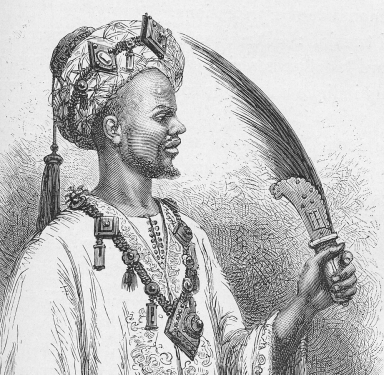
Samori's armies had to remain mobile, conquering new territory on one front, harassing the French on another, and doubling back to reoccupy old areas. The south-eastern front into Ivory Coast and Guinea took up most of Samori's attention after 1891, while his "burn and retire" tactics held off the Europeans in the West.
In 1898 Samori began an epic march towards Boribana, moving an estimated 120,000 civilians along with the army. The French commander Lartigue comments on this move as being carried out successfully with credible precision and speed. French pressure continued relentlessly however, and Samori’s force grew more constricted. He was captured by a small French striking force that burst into his camp from an unexpected direction in September 1898. His long struggle and disciplined organization however illustrates the capacity of indigenous systems to create new forms of organization, modify existing tribal ones, and adapt to new or improved technology.
Military reforms of Shaka
The Zulu are a significant case in African military innovation and change. Their system of war transformed large portions of the continent and their methods spanned both the pre-gunpowder and gunpowder eras. Tribal warfare among the Zulu area clans was heavily ritualistic and ceremonial until the ascent of the ruthless chieftain ShakaShaka
Shaka kaSenzangakhona , also known as Shaka Zulu , was the most influential leader of the Zulu Kingdom....
, who adapted and innovated a number of tribal practices that transformed the Zulu from a small, obscure tribe to a major regional power in Southern Africa. Many of the innovations of Shaka were not simply created out of thin air, nor can they be dubiously credited to the influence of European troops drilling several hundred miles to the south, nor can they merely be dismissed as the product of vague environmental forces like drought or overpopulation. Age-grade groupings, the advantages of an aggressive charge or encircling an enemy, etc. are all known in tribal warfare of the period. Elements of the regimental system for example had been put in place under his predecessor Dingiswayo. What was different was a much more ruthless combination and systematic use of all these elements to produce the distinctive Zulu system. Shaka sought to bring combat to a swift and bloody decision, as opposed to duels of individual champions, scattered raids, or light skirmishes where casualties were comparatively light. Such a brutal focus demanded changes in weapons, organization and tactics.
New weapons and new organisation

Logistics. The fast moving host, like all military formations, needed supplies. These were provided by young boys, who were attached to a force and carried rations, cooking pots, sleeping mats, extra weapons and other material. Cattle were sometimes driven on the hoof as a moveable larder. Again, such arrangements in the local context were probably nothing unusual. What was different was the systematisation and organisation, a pattern yielding major benefits when the Zulu were dispatched on military missions.
Age-grade regimental system. Age-grade groupings of various sorts were common in the Bantu tribal culture of the day. Shaka manipulated this system, transferring the loyalty of the traditional clan groupings to himself, thus strengthening his personal hegemony. Such groupings on the basis of age, did not constitute a permanent, paid military in the modern Western sense, nevertheless they did provide a stable basis for sustained armed mobilisation, much more so than ad hoc tribal levies or war parties. Shaka organised the various age grades into regiments, and quartered them in special military kraals, with each regiment having its own distinctive names and insignia.
Mobility and training. Shaka discarded sandals to enable his warriors to run faster. Initially the move was unpopular, but those who objected were simply killed, a practice that quickly concentrated the minds of available personnel. Shaka drilled his troops frequently, implementing forced marches that could cover more than fifty miles a day. He also drilled the troops to carry out encirclement tactics (see below). Such mobility gave the Zulu a significant impact in their local region and beyond.
Encirclement tactics. The Zulu typically took the offensive, deploying in the well known "buffalo horns" formation. The attack layout was composed of three elements:
- the "horns" or flanking right and left wing elements to encircle and pin the enemy. Generally the "horns" were made up of younger, greener troops.
- the "chest" or central main force which delivered the coup de grace. The prime fighters made up the composition of the main force.
- the "loins" or reserves used to exploit success or reinforce elsewhere. Often these were older veterans, sometimes positioned with their backs to the battle so as not to get unduly excited.
Organisation of the Zulu forces. The Zulu forces were generally grouped into 3 levels: regiments, corps of several regiments, and "armies" or bigger formations, although the Zulu did not use these terms in the modern sense. Size distinctions were taken account of, any grouping of men on a mission could collectively be called an impi, whether a raiding party of 100 or horde of 10,000. Numbers were not uniform, but dependent on a variety of factors including assignments by the king, or the manpower mustered by various clan chiefs or localities. A regiment might be 400 or 4000 men. These were grouped into Corps that took their name from the military kraals where they were mustered, or sometimes the dominant regiment of that locality.
Higher command and unit leadership. An inDuna
InDuna
InDuna is a Zulu title meaning advisor, great leader, ambassador, headman, or commander of group of warriors. It can also mean spokesperson or mediator as the izinDuna often acted as a bridge between the people and the king...
guided each regiment, and he in turn answered to senior izinduna who controlled the corps grouping. Overall guidance of the host was furnished by elder izinduna usually with many years of experience. One or more of these elder chiefs might accompany a big force on an important mission. Coordination of tactical movements was supplied by the indunas who used hand signals and messengers. Generally before deploying for battle, the regiments were made to squat in a semicircle while these commanders made final assignments and adjustments. Lower level regimental izinduna, like the NCOs of today's armies, and yesterday's Roman centurions, were extremely important to morale and discipline. Prior to the clash at Isandhlwana for example, they imposed order on the frenzied rush of warriors eager to get at the British, and steadied those faltering under withering enemy fire during the battle.
The Zulu in the gunpowder era
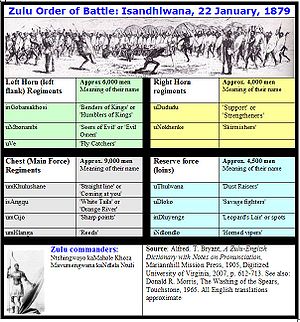
Morris (1965) holds that in the fluid situation, the commanding Zulu generals struggled to shape the battle and position their forces in the proper order as the warriors streamed forward, but only succeeded in holding back one corps (the Undi), and one regiment (the uDloko) which had been located a mile behind the main body. McBride (1976) maintains that the Zulu commanders were already well informed by their scouts (izinhloli) of British dispositions and only needed quick final directions to send the troops on their way - left horn to trap the British against the mountain, right horn to serve as blocking force and cut off the rear, chest to deliver main blow, and "loins" to drop deep, seal escape routes, and await further developments. These "tail end" reserves, who had been held in check by their unit commanders, were to later pursue fugitives and clash with the stalwart British defenders of Rorke's Drift. Whatever the final adjustments made, both writers show that the Zulu force, for all its eagerness, was no wild horde, but a disciplined formation, purposefully moving into combat according to its training and general battle plan.
The attack was met by withering British rifle, rocket and artillery fire that made part of the advance falter. The British however had divided their forces- part of it being away on a search for the main Zulu Army. That army materialized behind their backs at Isandlwana, and moved quickly to exploit the situation. Poor logistics and positioning of troops (scattered deployments, delayed ammunition resupply) also contributed to fatal weaknesses in the British defences, and the fiery exhortations of the regimental indunas encouraged the host of warriors to continue attacking. When British fire slackened, the Zulu prongs surged forward, smashing into the camp and annihilating its defenders. The liquidation of almost 1,000 European troops with modern arms by the tribal spearmen sparked disbelief and uproar in Britain. Aside from the losses of British regulars, and the supporting native levies, the Zulu impi killed more British officers at Isandhlawana, than Napoleon killed at Waterloo.
Defeat. Long term Zulu success against a major world power however was a questionable proposition. In his earlier encounters with European visitors to his kingdom, the Zulu King Chaka had dismissed firearms as ineffective against the massed charge of the regiments. At Isandhlawana, the monarch's boast held true. But as the Zulu War went on, massed rifle and artillery fire repeatedly broke the back of Zulu attacks, as they persisted in assaulting heavily fortified positions and failed to use captured firearms effectively. Despite earlier defeats by the Boers using guns, 4 decades earlier, the Zulu had not sufficiently adapted to the realities of firepower on the battlefield,. They also failed to effectively cut the vulnerable supply lines of their enemies- leaving the Natal rear area virtually untouched for example.
Contrary to popular belief many African armies did not have vast supplies of fighting personnel (see "Significant Influences" above). The war put tremendous pressure on the Zulus relatively limited manpower resources, a pattern repeated throughout Africa where comparatively small kingdoms clashed with European states like Britain or France. At Isandhlwana for example, the Zulu main force had marched for three days straight, without eating on the last two. As the regiments deployed for attack they had a four mile run to reach the British camp, before entering into the immediate battle. The reserve force of the impi, the uDokolo regiment, had another twelve mile run to make immediately after, where they attacked the fortified British position for ten hours straight. Such intensity could not be sustained with available manpower and logistics. At the final Battle of Ulundi
Battle of Ulundi
The Battle of Ulundi took place at the Zulu capital of Ulundi on 4 July 1879 and was the last major battle of the Anglo-Zulu War. The British army finally broke the military power of the Zulu nation by defeating the main Zulu army and immediately afterwards capturing and razing the capital of...
, the depleted Zulu formations showed little of their previous ferocity, and made a relatively token half-hour attack before being scattered.
Influence of the Zulu system
The Zulu military system was to transform large swathes of the continent, from south east Africa, into parts of East and Central Africa through the disruptive warfare that broke out during the reign of Zulu king Shaka. The disruption, known as the Mfecane had several causes, but it was to create several powerful nations in its wake, such as the Swazi, the Nebebele, the Shangaan and others. Many of these new powers copied Zulu methods, weapons and tactics, and saw a measure of success against both indigenous and foreign opponents. The Shangaan for example, founded by war-leader Shoshangana, were to migrate into what is now Mozambique and force the Portuguese into paying them tribute.Horses, guns and indigenous adaptation in Southern Africa

The powerful horse and gun system of the Boers. While not indigenous to the continent, the horse and gun system of the Boers, and their defensive wagon laager, was to have profound effects on military developments in the southern portion of Africa. Mounted warfare enabled them to beat or fight a wide variety of African enemies to a standstill, although they suffered their share of defeats over the decades. Skilled horsemen, and excellent shots, the Boers acquitted themselves well in a variety of tactical situations, against both African enemies and imperial forces. Several groups arose that emulated the horse and gun system. Prominent among these were the outcasts, the half-caste or mixed race product of Dutch and African interaction, and/or alliances with other dispossessed tribal elements- peoples like the Griqua, Bergnaars, Koranna and Basters. Acquiring weapons and mounts over the course of time, they too began to carve out their own sphere of influence in the region, alternately battling Boer, Bantu and Briton at various times in their history.
Rise of the Basotho system. Several tribal kingdoms such as the Tlokoa, Pedi and Basotho
Basotho
The ancestors of the Sotho people have lived in southern Africa since around the fifth century. The Sotho nation emerged from the accomplished diplomacy of Moshoeshoe I who gathered together disparate clans of Sotho–Tswana origin that had dispersed across southern Africa in the early 19th century...
took up horse and gun, despite collaboration between the Boers and the British to prevent such transfers, particularly of firearms. The Basotho, a small tribal grouping threatened by the Zulu, Ndebele, as well as the Europeans, adapted to both weapons systems, and carried out a complex mix of warfare and diplomacy to fend off their enemies. They became avid horsemen, and in time, developed the tough, durable breed, that was to be known as the Basuto pony. The Basotho equipped their mounted fighters with guns, although the traditional spear, battle-axe, and knobkerrie (club) continued in use. Most of the firearms were low quality flintlocks, and ammunition and gunpowder were usually in short supply. Marksmanship according to contemporary European observers was not as good as that of the Boers. The tribal warriors also relied heavily on fortifications in their mountainous country, the most famous of which was Thaba Boisu, fortress capital of their king Moshoeshoe.
Battles against English and Boer forces. The Basotho clashed with several enemies to maintain their fragile independence. In the 1840s they fought against the Tlokwa, who were also mounted, and against the Zulu-influenced Nedebele, who were primarily infantry. In 1851, a British colonial force invaded Sotho country and was soundly defeated at the battle of Kononyaba (or Viervoet). Against the British, who deployed an artillery piece, the spear and battle-axe proved more useful than guns when the Sotho hemmed in the invaders on a mountaintop. Victory was gained by close hand-to-hand fighting. This incident provided a significant check to British power in the area. The following year another British force tried its luck, and was also defeated. This encounter saw the widespread deployment of Sotho cavalry. At one point in the battle, some 6,000 Basotho horsemen mounted a charge against the British formation. They were repulsed by rifle and artillery fire. Nevertheless, the tribal regiments controlled the field at the end of the day, and the British withdrew.
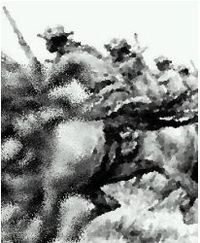
Another Boer invasion in 1867 was more dangerous for the Basotho. The Europeans had upgraded their rifles, obtained more powerful artillery, and augmented their numbers with white volunteers from across South Africa. Once again they converged on Thaba Boisu, liquidating local strongholds on the way. A first assault against the fortress ended in failure. A second drove the Basotho back from their advanced defence lines, but also became bogged down. A third also stalled when a Boer leader was shot dead. The conflict dragged on for 6 months as the Boers ravaged Basotho territory, seizing cattle, people and burning crops to bring their opponents to heel. In early 1868 however Moshoeshoe persuaded the British to intervene and placed his kingdom under crown protection. This ended the Boer siege although a subsequent treaty transferred yet more Basotho land to their enemies.
The 'gun war' - defeat of colonial forces. The Basotho continued to use their horse-gun system under the new colonial regime to maintain their independence. In the 1880s, their territory was annexed by Cape Colony and a punitive expedition
Punitive expedition
A punitive expedition is a military journey undertaken to punish a state or any group of persons outside the borders of the punishing state. It is usually undertaken in response to perceived disobedient or morally wrong behavior, but may be also be a covered revenge...
of 800 white troops and 1500 African allies was dispatched to crush the opposition of one Moorosi, a dissenting Sotho chieftain. Moorosi gathered some 300 gunmen in a strong mountaintop position and fought off the colonial forces for over 8 months. After three major assaults, and continuous shelling by artillery, the position was overrun, Moroosi was killed and his lands seized. As the struggle with Moorosi raged, colonial authorities reserved part of Basutoland for white settlement and demanded that all natives surrender their firearms. This demand was rejected and another British expedition was dispatched to liquidate resistance, sparking the so called "Gun War." The Sotho horsemen however used a flexible mix of tactics: defensive positions on fortified hills, attacks against administrative centers of the colonial regime, and frequent use of guerrilla strikes and ambushes against lumbering colonial columns, most notably a column of British lancers at Qalabani. The combination of mobility, firepower, ambushes, and hit and run strikes was sufficient to stalemate or defeat the Basotho's enemies for almost a year. Stymied, the colonial army, and the disarmanent demand was withdrawn.
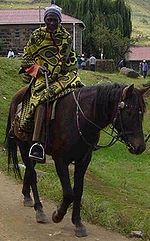
Adapting to modern arms: the Ethiopians at Adowa
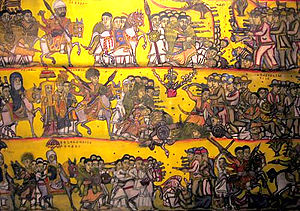
Battle of Adowa
The Battle of Adwa was fought on 1 March 1896 between Ethiopia and Italy near the town of Adwa, Ethiopia, in Tigray...
demonstrates the increasing ability of African forces to handle modern arms as gunpowder weapons began to dominate the field. Special role for this purpose was played by the Russian military advisers and volunteers of Menylik's army. So Little Leontiev's command of the Russian volunteers and advisers could be the direct participants of battle near Adwa in composition the Ethiopian army (less than fifty).
Painful lessons in the killing efficiency of rifled firepower had been dealt the Ethiopian forces in earlier encounters with European armies. At the battle of Aroge for example, British volleys from breechloading rifles crushed the Emperor Tewodros' troops, and the British campaign was to end in his death and the destruction of his capital.
Adaptations to modern arms. Others learned however. Tewodros's successor, Yohannes IV had been backed by the British and received 500,000 pounds (sterling) worth of military equipment. This was put to good use against a variety of other enemies, including the Mahdi's dervish forces from the Sudan, and in inflicting a crushing defeat on an Italian force at the Battle of Dogali
Battle of Dogali
The Battle of Dogali was fought on 26 January 1887 between Italy and Ethiopia in Dogali near Massawa, in present-day Eritrea.On his own initiative, Ras Alula Engida, then governor of Emperor Yohannes IV, had attacked the Italian-controlled town of Sahati on the day prior...
in 1887. In 1875 and 1876, Yohannes' troops also defeated substantial Egyptian armies trained and officered by European mercenaries and US Civil War veterans. The Egyptians had been equipped with Remington rifles, Krupp artillery, Gatling guns and rocket tubes. This hardware was transferred to the victorious Ethiopian forces, and captured Egyptian gunners were pressed into service, training the Ethiopians to use the big guns. Military and diplomatic links with other nations such as Imperial Russia (chief military mission in the war-time Nicholai Leontyev) were also established. Yohannes' successor Menelik continued the armed buildup, and by the 1890s the Ethiopians were a tough fighting force on their own ground, capable of mobilizing massive numbers of infantry.
Historian Bruce Vandervort in Wars of Imperial Conquest in Africa, 1830–1914, notes that around 100,000 Ethiopian soldiers fought at Adowa, with about 70,000 of them carrying modern repeating rifles. The bulk of these were infantry. The remaining 30,000 men fought with traditional weapons- spear, sword and buffalo-hide shield. The Ethiopians also deployed a number of machine guns, and were the only Africans to employ artillery to any extent during the colonial wars. Some of their gunners were foreign, but many were indigenous artillerymen, who took over the batteries captured from the Egyptians. The performance of the artillery arm proved a key factor in the Ethiopian victory. Their "quick- firing Hotchkiss artillery forced the surrender of an Italian fort in the run-up to the battle of Adowa, and actually outgunned an Italian battery at a crucial point during the battle itself.". In many ways the Ethiopian army at Adowa was a traditional one that lacked the industrial base and elaborated military establishment of the typical European force. Proficiency however had been gained through long years of campaigning, as the various emperors consolidated power over internal and external foes.
- "Taken all together, the Ethiopian Army was formidable by any standards. Its tough fighting men were masters of both skirmish, or ambush warfare and shock action. A rare combination by African standards, and one that often caused unpleasant surprises for Ethiopia's enemies."
Such proficiency however masked many internal weaknesses, including poor logistics, and lack of advanced standardization in organization. Before the battle for example, the Emperor was considering leaving the field because of low supplies. Such deficiencies would count heavily against the indigenous forces in later years when faced with a new Italian invasion under Mussolini in the 1930s. Nevertheless on the day of Adowa, the Ethiopians were supremely ready for the struggle before them.
The battle. At Adowa, the Italian force, estimated at 18,000 were heavily outnumbered, but had good rifles and some 56 pieces of artillery, and was also stiffened by high quality, elite bersaglieri and alpini units that marched with some 15,000 European soldiers supported by a smaller number of 3,000 African askari. Prior to the encounter, their commander Bartieri dug into a strong fortified position, hoping to lure the Ethiopians into attacking him. They did not oblige, and a stalemate ensued. Urgings from Rome prompted Bartieri to advance against the Ethiopian concentration at Adowa. The Emperor was considering retreat as supplies ran low, but also hoped that by maneuver, he would draw out his opponents.
The Italian advance set the stage for battle. Their forward movement on Adowa was a confused affair and their columns became separated. Ethiopians troops positioned themselves to intercept, and covered by accurate artillery fire, launched a fierce attack that took advantage of this vulnerability, rolling up the Italian line with continuous pressure. They killed over 3,000 Italians and wounded hundreds. A smaller number of African soldiers in Italian service, about 2,000, were also killed, and over 1,000 wounded. A further 954 Italian troops were missing in action, and the army lost some 11,000 rifles, all of its 56 artillery pieces, and had to endure guerrilla attacks as it pulled back from the killing zone. Ethiopian losses were about 7,000 dead and 10,000 wounded. Thousands of European captives were taken, and the Italian government paid some 10 million lire in reparation money for the survivors after the defeat. Some 800 Tigrean askari troops who fought for the Italians met a more brutal fate. Considered traitors, they had their right hands and left feet cut off. Although the Ethiopians were to be less successful or prepared some 40 years later against Mussolini's troops, the victory at Adowa, which repeated the smaller triumph at Dogali some 9 years earlier, was to become a landmark in African military history.
Significance of the Adowa victory. News of the disaster caused the fall of the Crispi government
Francesco Crispi
Francesco Crispi was a 19th-century Italian politician of Arbëreshë ancestry. He was instrumental in the unification of Italy and was its 17th and 20th Prime Minister from 1887 until 1891 and again from 1893 until 1896.-Sicily:Crispi’s paternal family came originally from the small agricultural...
in Italy and riots in urban areas. The shock of Adowa exceeded the British shock at Isandhlwana, with both disasters magnified by the realization that indigenous forces had beaten modern European regulars in the open field. As one Italian historian notes:
- "It was the realization that their belief in their superiority over the "blacks" was an illusion.. A whole swaggering ethos.. of conquest was shattered before the eyes of soldiers who saw thousands of human lives snuffed out in a few hours in a strange and hostile land with no possibility of defence, who succumbed before a people who had been reduced to semi-savages in their eyes, who were beaten by an African army depicted right up to the eve of battle as disorganized, poorly armed and incapable of formulating a strategy."
While Adowa has attracted much attention in a political and African nationalist sense, one Western military historian notes that the battle was a relatively costly affair for a European army in terms of force-ratio casualties- indeed one of the most proportionately costly major battles of the 19th century.
- "Baratieri's army suffered 50 percent casualties, far higher than those suffered by participants in any other major battle of the nineteenth century. Eylau, the greatest blood-letting of the Napoleonic era, cost the French army casualties of 33.8 per cent and its losses at Waterloo were just under 30 per cent. "Macello, carneficina, strage" (butchery, slaughterhouse, slaughter) are the words which recur in the memories of the Italian combatants at Adowa."
Summary of African military systems: 1800-1900
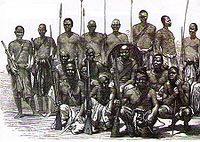
Indigenous military organization also encompasses Africa’s substantial cavalry or mounted tradition, from the armored chevaliers of Western Africa, to the desert horsemen of North Africa, to the mounted fighters of the Basotho in their southern redoubts. On the waters of the continent, naval activities must be accounted for, not simply canoe transport, but fighting vessels, ports, and troop landings covered by poisoned arrows, bullets and cannonballs. Different styles of warfare and modes of organization are also demonstrated by indigenous systems, from the patient tactical defensive of the Basotho, the elaborate armies of Ashanti, the sweeping offensive horns of the Zulu impi, and the protracted guerrilla styles and archery of forest peoples like the Lobi, or the San (Bushmen) further south. As regards styles of organization, different approaches over different eras can be seen. Among the Kongo kingdoms of the 18th century for example, a mixture of unit types was deployed - heavy infantry with strong shields for example, backed by lighter contingents armed with bows and spears. Special units of elite troops and bodyguards were also maintained. Like the reorganized Roman legions of old however, the later Zulu system dispensed with such distinctions in favor of one streamlined combat organization and method. Such standardized methods were to be copied by other tribes, and were to dominate or influence large parts of southern Africa and beyond during the 19th century. Such complexity again illustrates that African military systems cannot be conceived of in static, one-dimensional terms.
The introduction of firearms does not tell the whole story of the 19th century due to their mixed impact and use in many regions. Indeed, some historians argue that mere advanced technology was not the single most decisive factor in the outcome of many colonial conquests. More important, was the divided, fragmented nature of many small African polities that enabled them to be defeated separately by their enemies. Such fragmentation is not unique to Africa. Germany for example in 1815, was split into over 30 separate states. Despite these weaknesses, until well into the second part of the century, many native forces held their own until the coming of modern artillery, machine guns and rifles.

See also
- African military systems to 1800African military systems to 1800African military systems to 1800 refers to the evolution of military systems on the African continent prior to 1800, with emphasis on the role of indigenous states and peoples. Development of the military art generally moved from the simple to the more sophisticated as economies and cultures became...
- African military systems after 1900African military systems after 1900As the 20th century started, most of Africa, with the exception of Ethiopia and Liberia was under colonial rule. By the 1980s, most nations were independent...
- Military history of AfricaMilitary history of AfricaThe military history of Africa is one of the oldest and most eclectic military histories. Africa is a continent of many regions with diverse populations speaking hundreds of different languages and practicing an array of cultures and religions...
- Ashanti EmpireAshanti EmpireThe Ashanti Empire , also Asanteman was a West Africa state of the Ashanti people, the Akan people of the Ashanti Region, now in Ghana. The Ashanti or Asante are a major ethnic group in Ghana, a powerful, militaristic and highly disciplined people of West Africa...
- ImpiImpiAn Impi is an isiZulu word for any armed body of men. However, in English it is often used to refer to a Zulu regiment, which is called an ibutho in Zulu. Its beginnings lie far back in historic tribal warfare customs, where groups of armed men called impis battled...
- Military history of AfricaMilitary history of AfricaThe military history of Africa is one of the oldest and most eclectic military histories. Africa is a continent of many regions with diverse populations speaking hundreds of different languages and practicing an array of cultures and religions...
- Mali EmpireMali EmpireThe Mali Empire or Mandingo Empire or Manden Kurufa was a West African empire of the Mandinka from c. 1230 to c. 1600. The empire was founded by Sundiata Keita and became renowned for the wealth of its rulers, especially Mansa Musa I...
- Military history of the Mali EmpireMilitary history of the Mali EmpireThe military history of the Mali Empire is that of the armed forces of the Mali Empire, which dominated Western Africa from the mid 13th to the late 15th century. The military culture of the empire’s driving force, the Mandinka people, influenced many later states in West Africa including...
- Kingdom of NdongoKingdom of NdongoThe Kingdom of Ndongo, formerly known as Dongo or Angola, is the name of an early-modern African state located in what is now day Angola. Ndongo was built by the Northern Mbundu people, a Bantu-speaking people inhabiting northern Angola....
- Kingdom of MatambaKingdom of MatambaThe Kingdom of Matamba was a pre-colonial African state located in what is now the Baixa de Cassange region of Malanje Province of modern day Angola...
- Kingdom of KongoKingdom of KongoThe Kingdom of Kongo was an African kingdom located in west central Africa in what are now northern Angola, Cabinda, the Republic of the Congo, and the western portion of the Democratic Republic of the Congo...
- Nzinga of Ndongo and MatambaNzinga of Ndongo and MatambaNzinga Mbande , also known as Ana de Sousa Nzinga Mbande, was a 17th century queen of the Ndongo and Matamba Kingdoms of the Mbundu people in southwestern Africa.-Early life:...
- Battle of MbwilaBattle of MbwilaAt the Battle of Mbwila on October 29, 1665, Portuguese forces defeated the forces of the Kingdom of Kongo and decapitated king António I of Kongo, also called Nvita a Nkanga.-Origins of the War:...
- Battle of ZamaBattle of ZamaThe Battle of Zama, fought around October 19, 202 BC, marked the final and decisive end of the Second Punic War. A Roman army led by Publius Cornelius Scipio Africanus defeated a Carthaginian force led by the legendary commander Hannibal...
- Battle of IsandlwanaBattle of IsandlwanaThe Battle of Isandlwana on 22 January 1879 was the first major encounter in the Anglo-Zulu War between the British Empire and the Zulu Kingdom...

